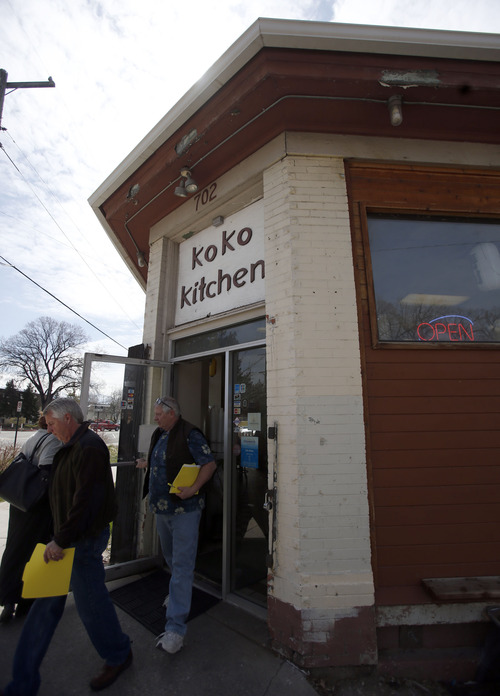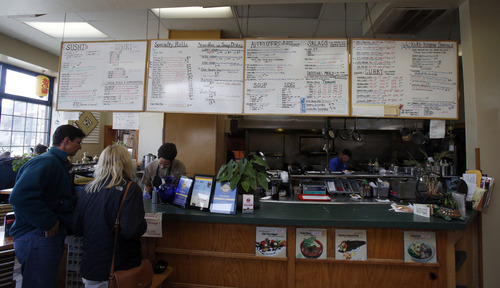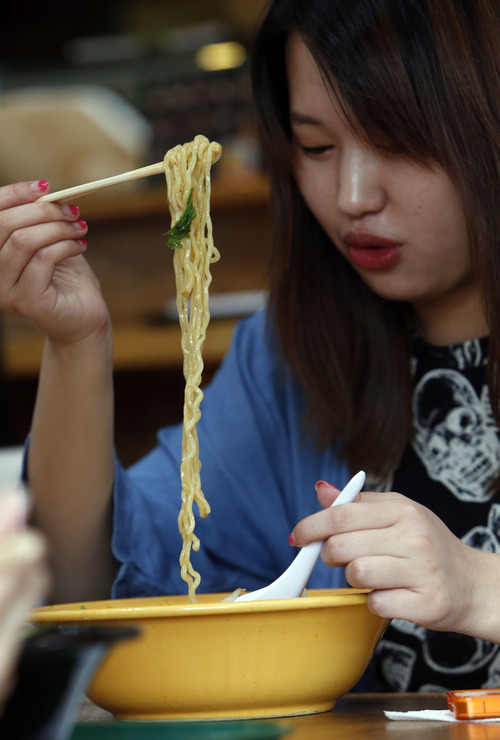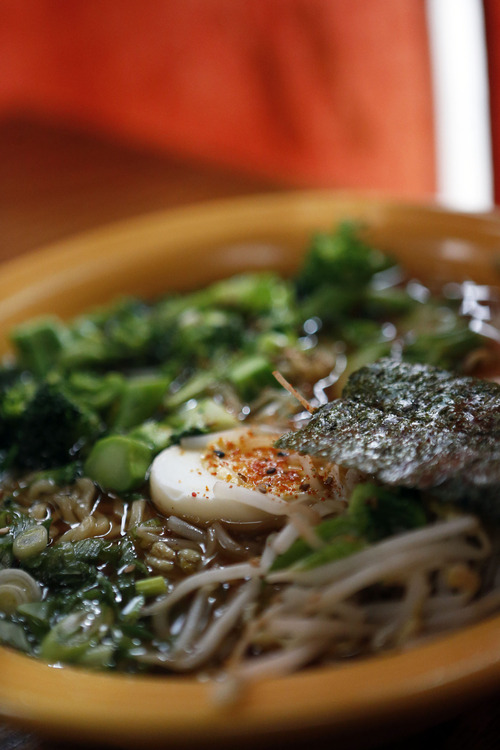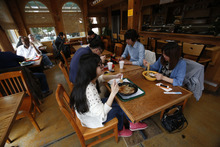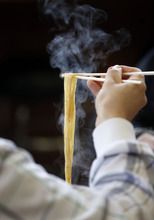This is an archived article that was published on sltrib.com in 2013, and information in the article may be outdated. It is provided only for personal research purposes and may not be reprinted.
Mention the word ramen and it will evoke images of the thin, dry noodles in cellophane packages that have sustained generations of starving college students — not exactly haute cuisine.
But in recent years, traditional ramen has been appearing on restaurant menus around the U.S. and in Utah. Instead of two minutes in the microwave, the broth for original ramen can take two days to prepare.
"Some of the customers here don't want to try the ramen because they think it's Cup Noodles — it's not that," said Kyoko Bannai, who owns and operates Koko Kitchen with her son Jiro.
Bannai immigrated to the U.S. more than 40 years ago and has been serving Japanese food at her Salt Lake City restaurant for the past 16 years. She said ramen egg noodle originated in China, but after it was introduced in Japan, the country quickly adopted the dish. "Every region in Japan makes its own style," she said. "In Japan, some people are so crazy for ramen they travel all over to try all the different styles."
What distinguishes one region's ramen from another is the broth and choice of toppings.
The ramen at Koko Kitchen's is similar to what would be found in Tokyo. The noodle dish uses both pork and chicken broths flavored with shoyu, Japanese soy sauce. The bowls are garnished with bean sprouts, chopped green onions and a hard-boiled egg, cut in half. Customers get their choice of chicken, tofu or, the restaurant's best seller, Chinese-style barbecue pork called char siu.
Even though it sounds like hearty winter fare, ramen is served year round, said Bannai.
While they offer chicken and vegetarian variations, the pork ramen is the most popular ramen at Salt Lake City's Plum Alley restaurant. No surprise that it also is the favorite of Tara Juhl, the restaurant's chef de cuisine.
"I love our pork ramen. It has pork belly and the smoked pork," Juhl said. "Add a little sriracha and that'll make my day. And then I'll have to have a nap."
Instead of the traditional boiled egg, Plum Alley places a poached egg in every bowl. When broken, the runny yolk blends with the pork-heavy dish, becoming something akin to liquefied bacon and eggs. There are also slices of pickled ginger to help cut through those savory notes.
Plum Alley also makes its noodles in house. The restaurant is always experimenting trying to make the noodles better, Juhl said. "You have to have that perfect balance between having a bite to it and softness."
Some ramen aficionados focus on the texture of the noodle while others think it's the broth that makes the dish. Juhl just enjoys taking it all in.
"It is an experience eating it — sitting down with a bowl of soup that's bigger than your head," Juhl said.
The broth is definitely the most time-consuming part of making real ramen, simmering pork or chicken bones with a variety of vegetables to create the sumptuous soup takes several hours.
Newcomers may find that eating a huge bowl of ramen noodles can be problematic simply because there's no graceful way to do it.
Experts suggest using both chopsticks and the Asian-style soup spoon — a kind of mini ladle — for a two-prong approach. Grab some noodles with the chopstick and place them in the spoon. Then dunk the spoon in the broth for a perfectly constructed bite of both noodles and soup.
Johnny Kwon, owner of Naked Fish Bistro has another tip: "Slurp."
"My wife tries to teach our kids good table manners but when it comes to ramen she tells them to slurp away," he said.
Naked Fish serves two varieties of ramen, the rich pork-based tonkotsu ramen and the lighter, leaner, chicken-based shoyu. Both are available only during lunch.
While Kwon doesn't have immediate plans to add ramen to his dinner menu, he does believe there's a bright future for the humble Japanese noodle dish in Salt Lake City, if diners — including his son — learn to look past the stigma of instant ramen.
"For my youngest son — it's so funny — his favorite food is ramen," Kwon said. "The first time he had Chef [Toshio Sekikawa's] ramen he said, 'This is the best Top Ramen I've ever had.'"
5 places for real ramen
Dojo Restaurant and Sushi Bar • 423 W. 300 South; Salt Lake City; 801-328-3333. Open Monday-Saturday from 11:30 to 10:30 p.m.
Koko Kitchen • 702 S. 300 East,; Salt Lake City; 801-364-4888. Open Monday-Thursday 11 a.m. to 9:30 p.m.
Naked Fish • 67 W. 100 South,; Salt Lake City; 801-595-8888. Open for lMonday-Saturday 11:30 a.m. to 10 p.m.
Plum Alley • 111 E. 300 South,; Salt Lake City; 801-355-0543. Open for Monday-Friday 11:30 a.m. to 10 p.m. with extended hours Friday and Saturday.
Rice: Asian Fusion Cuisine And Sushi Bar • 1158 South State St., Salt Lake City; 801-328-3888. Open Monday-Saturday 11 a.m. to 10 p.m. and Sunday noon to 9 p.m.


